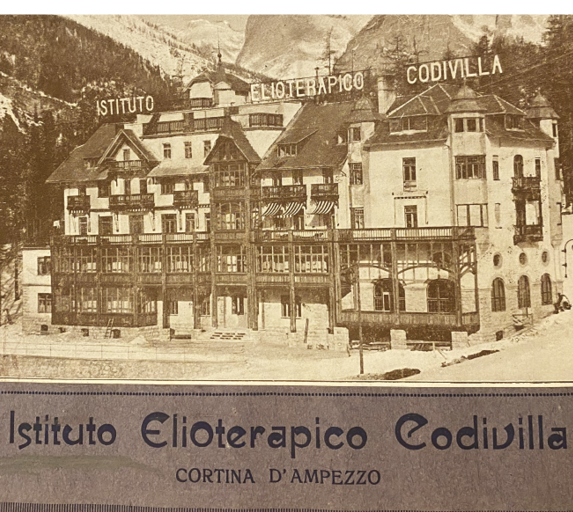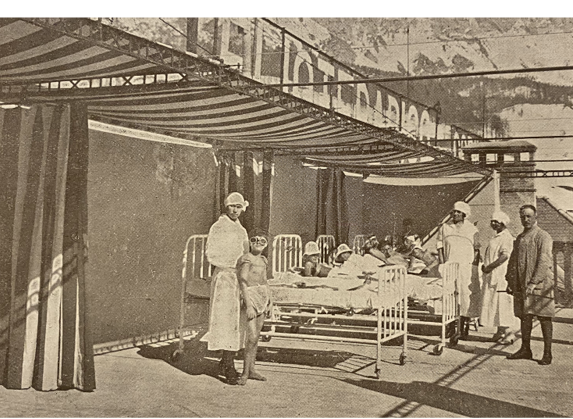In April 1924, the City Council of Bologna signed an agreement with the Rizzoli Orthopedic Institute for the reception and treatment of poor patients, “with assumption of the burden of costs,” in the Heliotherapy Institute in Cortina d’Ampezzo, inaugurated on 23 September 1923 as the first Italian high-altitude sanatorium devoted exclusively to the treatment of bone tuberculosis and osteoarticular diseases, “under the auspices of an illustrious name in the history of Italian orthopedics,” professor Alessandro Codivilla (1861-1912), in whose memory it was named.
Founded for scientific and charitable purposes, the Rizzoli Institute purchased the “Grand Hotel des Alpes,” an old Austrian hotel that was partially destroyed during the First World War, as a treatment center for the hospital’s patients (after the City and Province of Bologna had decided not to participate in the purchase, which they considered too costly), at the urging of Codivilla’s student Vittorio Putti, in charge of the entire project. The new Institute, located at 1350 meters above sea level, was the first Italian sanatorium devoted to the treatment of bone tuberculosis. It had an advantageous geographic position, surrounded by a forest of fir trees and by the Dolomite mountains, which, at 3000 meters, ensured clean air full of oxygen and balsamic essences.

Known since the late 1800s, high-altitude treatment combines the benefits of outdoor life with heliotherapy, a technique that rehabilitates patients by exploiting the beneficial effects of the sun, which at that altitude provide optimal conditions of light, chemical, and heat emission, acting on the patient’s body but avoiding sunstroke thanks to the fresh, clean air. With this therapy, the seriously ill body “is transformed, made strong and full of life, tempered by the rough Alpine climate.”
After further negotiations, the City partially revised its position, acknowledging the Institute’s great benefit and re-establishing relations with the willingness to contribute to the project in a manner conforming to the nature of a public authority.
“The mutual desire to collaborate” became a fruitful cooperation aimed at adoption of the resolution approved to define the criteria for hospitalization of ill people at the City’s expense, based on an agreement calling for the daily treatment of five Bolognese patients with a maximum annual total of 1825 days of hospitalization, for a duration of 10 years.
The City Department of Health and the Director of the Rizzoli Institute decided whom to send to the Heliotherapy Institute, with a “strong recommendation” regarding tuberculosis patients “who caught the disease due to the exertions and hardships of the war.” The City paid for their stay, treatment, and all of the therapies deemed necessary by the Medical Director as a result of the healthcare demands of the patients’ conditions and age.
The Heliotherapy Institute was on five floors and also had paying patients. The third floor had patients sent by the Province and by the City, by the Rizzoli Institute, and by charities, with three or four per room, divided by age and gender in comfortable, elegant settings with large windows for maximum fresh air and sunlight. In the hottest hours of the day, the patients were moved in the large “Stigler” hydraulic elevator, which could hold one bed or two stretchers, to the large solarium on the roof, where they stayed for the time needed for sun treatment.

The City’s support of poor social classes for the treatment of a serious disease such as tuberculosis was an example of that special form of social protection it provided to the population and, especially, to children, in schools, nurseries, and summer camps, where they studied and lived in the open air and in the sun. These principles were the foundation for the opening of the Fortuzzi elementary school in the Giardini Margherita in 1917.
We thank San Giorgio in Poggiale, Library of Art and History, Bologna.
The photos are from the brochure "Istituto Elioterapico Codivilla in Cortina d’Ampezzo (metri 1350 sul livello del mare); fondato e diretto dall’Istituto Ortopedico Rizzoli di Bologna, 1923”, Capodistria, Priora, 34 pages

.jpg)



.png)